1ST NHRC-NUSRL NATIONAL MOOT COURT COMPETITION, 2023
The National University of Study and Research in Law is pleased to be hosting the inaugural edition of the NHRC-NUSRL National Moot Court Competition from 24th-25th March, 2023. This event has been organized in joint collaboration with the National Human Rights Commission. We are pleased as punch to have SCC-EBC as our knowledge partner. This moot court competition aims to create awareness about human rights and foster interest in the ever-so-enormous domain of human rights. It is going to be a honing experience for budding lawyers to sharpen their argumentative skills and legal knowledge so that they can implement the same in future practice. The moot proposition revolves around the prevailing and hotly-contesting contemporary issue of environment v. development. It encompasses diverse legal fields and expects participants to argue upon human rights, constitutional law, mining law and tribal rights.
The following are the categories of rewards – the winning team would be awarded INR 20,000 and three 1-year SCC Online Web Edition (academic) subscriptions worth INR 24,000 each. The runners-up would be awarded INR 15,000 and three six-month SCC Online Web Edition (academic) subscriptions worth INR 14,500 each. The best speaker and best memorial each would be awarded INR 5000 and one six-month SCC Online Web Edition (academic) subscription worth INR 14,500. The best researcher would be awarded INR 5000.
This event would not have come to fruition without the cumulative efforts of the Moot Court Committee of NUSRL wherein students invested laser-focused efforts and dedication, setting this competition as a guiding light for many more events to follow. It is very encouraging to see the participation of 16 teams from esteemed institutions spread across the country. Thus, we welcome you to the inaugural edition of the NUSRL-NHRC National Moot Court Competition with great fervour. Hoping for an eventful and exciting set of two days, we announce the beginning of the rounds!
DAY 1: REGISTRATION AND THE PRELIMINARY ROUNDS
8:30 AM (REGISTRATION)
The registration desk is rife with hustle and bustle of zealous teams eager to make their way to the courtrooms, while the judges were being briefed by the MCC Organising Team.
9:00 AM ROUND 1 (PRELIMS) The day of judgement has arrived. The teams greet the judges with cold feet and a tinge of aspiration in their eyes hoping that months of preparation and effort come to fruition. The teams come armed with weighty compendiums of authorities. Some are intimidated by the volley of questions posed by the honourable judges while others remain unruffled, braving them with calm and poise. The petitioners were thinking on their feet, showcasing the great presence of mind. The respondents displayed impeccable knowledge of the intricacies of the law to the astonishment of everyone. The rounds ended with constructive feedback by the pleased judges who emphasised the importance of holding one’s ground and reading between the lines of facts.
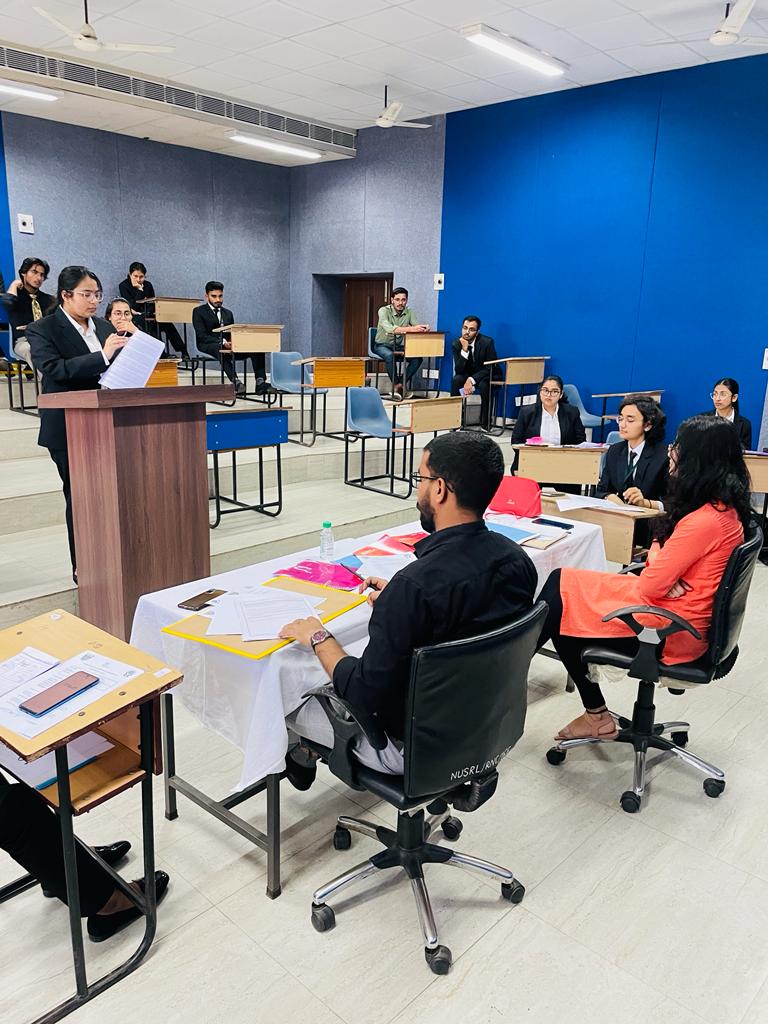
10:15 AM– The court masters and the teams rush to their respective courtrooms for the second round.
10:40 AM ROUND 2 (PRELIMS) The courts resettle for another engaging round of proceedings. The judges seem to have made a consensus to grill the orators over the nitty-gritty of the memorial submissions. The judges questioned the knowledge of the petitioners pertaining to the relevant provisions of the Constitution of India. In the flow of arguments, the respondents inadvertently accede to the fact that they provided ‘shady’ residences as rehabilitation. The judges call it a day with encouraging feedback and a feeling of relief that resonates in the court.
12:00 PM (FELICITATING THE JUDGES) The organising team expresses its heartfelt gratitude to the judges for taking out time from their hectic schedules to grace the occasion via a token of appreciation.
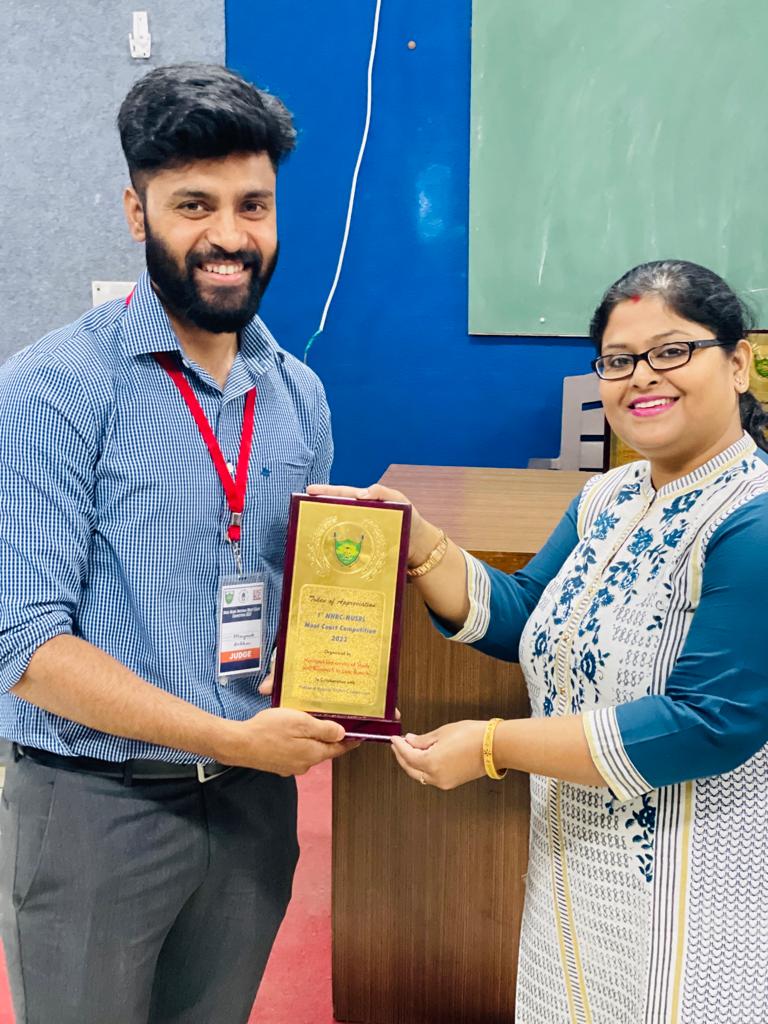
12:15 PM (LUNCH) Everyone enjoys the delicious lunch while engaging in friendly chatter with participants and judges alike.
4 PM (RESEARCHER TEST) After a period of relaxation, all researchers assembled for the Researcher Test. The researchers were asked to answer 5 questions to be submitted within an hour. The teams disperse to gear up for Day 2.
5:00 PM (RELEASE OF LIST OF SEMI-FINALISTS) Having completed the scheduled standings for Day-1, the anxiously anticipated list of semi-finalists is released by the organizing team.
The semi-finalists are:
TC-04 – University Law College, Vinoba Bhave University, Hazaribagh.
TC-13 – NALSAR University of Law, Hyderabad.
TC-09 – Army Institute of Law, Mohali.
TC-07 – Dr. B.R. Ambedkar National Law University, Sonipat.
The teams disperse to gear up for Day 2.
Day 2: Semi-Final and Final Rounds
Semi-Final Rounds
Having honed the glory on the first day, the semi-finalists are posed with an amalgamation of delight and fright. The day is scheduled to host the semi-finals and finals of the competition. While the bliss of making it through to the semis slowly dwindles, the excitement and drama of the finals is hauntingly apparent. The question of who is better prepared may no longer be a matter of who worked harder or who dedicated more time to drafting, but of who is capable of keeping calm and being consistent. Noting that winning the competition is just as probable as fumbling the victory, it would be a delight to see the participants think and compete.
COURTROOM 1: TC—09 v. TC—13
PETITIONER:
10:23 A.M. – CR 1 is abuzz with excitement as the semi-final rounds are about to begin shortly. The teams are vehemently discussing their creative strategies. The tension in the room is palpable as the bench goes through the memorials of the teams. With the stage set and the competition crisp, the race to the finals commences!
10:28 A.M. – The Petitioners take the podium. Counsel-1 briefly summarizes the interesting facts of the case. The issues are specified, and it seems that the much-apprehended grilling is about to begin. However, counsel 01 is on her guard for she seems to be armed with a plenitude of formidable case laws that support the team’s case. The bench is evidently impressed with the veracity of the arguments.
10:37 A.M. – The bench pitches confounding questions about the jurisdiction of the case. The Counsel effectively thinks on her feet and answers all the questions thus proceeding with further issues. She pleads her case with an impressive set of claims backed by various factual and logical premises. Meanwhile, time is running out but counsel 01 seems to have an unending stock of arguments. However, only so much can be said in so little time. Thus, the courtroom awaits her best arguments in the remaining time so that the team establishes their case with flying colours!
10:44 A.M. – The bench now challenges the case of the Petitioners with real life case studies and subjected the case established by them to vulnerable questions. They also point out the lack of statistical figures. Here, the intricacy of the research of the Petitioners is established as they answer the questions with their own elaborate sets of case studies. Furthermore, she effectively segments her arguments to substantiate the laid claims with intricate pieces of information from the fact sheet.
10:52 A.M. – With one minute left to her allotted time, she establishes a conclusive utilitarian claim by pointing out the grave costs compared with the frugal benefits. A grave violation of Fundamental Rights is pointed out. It is pleaded that development cannot be allowed to prevail at the expense of the environment. They establish that the need of the hour is to prioritize environmental health. However, the judges seem unconvinced and demand a middle ground between the contrasting sides of the spectrum. To this, the petitioners suggest innovative eco-friendly power solutions like solar energy, hydrogen fuel, etc.
10:59 A.M. – Concluding her arguments by deriving authority from the Fundamental Rights themselves, the podium is taken by Counsel-2. The second speaker substantiates the case established by the petitioners by adding to it the support of various international declarations with India as its signatory. The open disregard to various safety measures by the PSU in question is pointed out and thus, a case of common detriment of the general populace is pleaded. Moreover, the violation of various significant national environmental acts are pointed out.
11:06 A.M. – The judges look engaged in the various factual backings provided in the memorial and compendium. After thorough examination, the bench claims that the case made by the petitioners is sheltered on eggshells since they plead for something extreme—the complete closure of a Public Sector Undertaking for environmental reasons. The co-counsel takes help of the concept of absolute liability. However, the bench does not let them off easy and asks if all PSUs shall be shut down if they all flout one rule on another. The co-counsel convincingly established the exceptionally grave violation of environmental concerns in the present case thus necessitating their plea.
11:12 A.M. -The co-counsel proceeds with the second issue to establish the violation of fundamental rights of the populace by the PSU. They demand rehabilitation and compensation for the affected workers and population. The sub-issue is backed by premises from the fact sheet and the Indian Constitution. It is established that the PSU is only a disguised helping hand for the villagers as, in the name of employment, the villages are treated unethically and worker-welfare measures are not abided by.
11:19 A.M. – Yet again, the petitioners find themselves running against time and concisely add justifications to their issues. Thus, the prayer is recited, and the petitioners rest their case.
RESPONDENT:
11:23 A.M. -The counsel for Respondents makes a bold start by pleading that the instant petition should be furtively dismissed. They claim that the petition is not fit to be pleaded in the present court. The bench seems impressed by the elaborate justification of lack of jurisdiction and the counsel proceeds to the second sub-issue without much criticism. In the larger thematic debate of Environment v. Development, the Respondents back development. Various relevant case laws are cited to further the claim that no relevant legal provisions have been violated.
11:30 A.M. – Further, the stance of lack of need of environmental assessment is effectively defended. So far, the Respondents have not been subjected to thorough questioning by the Bench. By citing an unending stock of cases, laws and research documents, it seems that the Respondents have successfully satiated the enquiry of the Bench so far. Finally, the grilling begins as the judges inquire about the lack of reasonable care on the part of the PSU. Questions regarding the nitty-gritty details of the factsheet are bombarded. The counsel admits the limit of his knowledge at one point, but the Bench, unrelentingly, proceeds with further questioning.
11:39 A.M. – The counsel is compelled to confront the lack of welfare measures on the part of the PSU. The Respondents find themselves in a pickle. The Bench seems to be demanding particular sections from the Pollution Control Act. The counsel is made to face a possibility of permanent closure of the PSU that they are defending. They are finally made to admit the need for adopting measures for zero-possibility of lapse of safety measures for future sustenance of the PSU.
11:42 A.M.– Proceeding with further sub-issues, the counsel points out the need for fundamentally prioritizing development. Time runs out, and the courtroom awaits final arguments from the co-counsel. The co-counsel is well-revised with arguments. He specifies with impressive clarity how in the present case, mere non-compliance does not suffice to plead for closure of the PSU. Reports are cited to prove that for closure, compliance must be checked by an independent scientific body or statutory body.
11:51 A.M.– Fallacies in the analogies drawn by the Petitioners are pointed out. The co-counsel claims that the case studies cited by them are of little relevance in the present case. Furthermore, all the safety measures adopted are pointed out from the factsheet. On this sub-issue, the co-counsel has escaped questioning and proceeds with further arguments. The recurring question of sustainable development comes along, and the judges demand apt justification for the same.
11:57 A.M.– Yet again, the respondents are compelled to admit a limited knowledge of facts. Thus, confrontation on lack of compliance measures by the PSU continues. The co-counsel continues to face questions with confidence and backs all answers by citing appropriate authorities. Violation of human rights by the closure of the mine is pointed out, something that has remained unacknowledged so far. The livelihood of all the workers that depend on the PSU being defended is referred to.
12:04 P.M.– On a concluding note, the co-counsel pleads for a more reasonable measure instead of a knee-jerking hasty decision. Protection of indigenous population is recommended, awareness drives and strict compliance with safety measures are promised. The ultimate plea of the Respondents is to allow the PSU to keep running. Time runs out and the Rrespondents proceed towards their prayers. And now, the rebuttals begin!
12:12 P.M.– With a pushing limit of three minutes, the counsel for Petitioners effectively defends their jurisdiction while establishing their case of maintainability. The question of safety measures is raised again, and it is said that in the light of the vulnerable nature of the population, the measures are in no way adequate. The counsel concludes the rebuttals by pitching that no major questions asked by the petitioners have been answered. They claim that the respondents have merely shrugged responsibility claiming ignorance on the basis of the factsheet.
12:18 P.M.– In the sur-rebuttal rounds, the Respondents circumstantially acknowledge everything asked. They defend their stance of no violation of Fundamental Rights. Rather, the Respondents claim that the Petitioners have not acknowledged hindrance in energy development in the nation. They re-emphasize their contention that the matter be remanded back to a body of appropriate jurisdiction and conclude by demanding an alternate remedy.
12:21 P.M.– Thus, the semi-final rounds conclude with a hint of tension in the air. The courtroom disperses and the judges engage in the much awaited process of evaluation.
COURTROOM 1: TC—04 v. TC—07
PETITIONER:
10:25 A.M.– The petitioner’s side, by taking due permission from the judges, have started by presenting arguments pertaining to the maintainability of the suit.
10:29 A.M.– Advancing their arguments regarding the maintainability, they’ve filed a writ petition in the Hon’ble Supreme Court. No sooner than now, the judges have started shooting questions on the counsel. Starting off with whether the court’s jurisdiction extended to the matter and why prior remedies were not exhausted before coming to the Supreme Court?
10:33 A.M.– Counsel brilliantly handling the situation says we’ve come directly to SC as the powers of this honourable bench is at par with any of the other tribunals.
10:37 A.M.– Moving ahead, he says there is an infringement of fundamental rights of their client and for writ petitions only two remedies are available- in the HC and the SC. As they previously approached the HC and didn’t get the decision in their favour, they’ve pleaded before the SC now.
10:41 A.M.– The counsel now puts forth the grievances caused to the tribal people and justifies their stand of seeking a closure of the company. To this, comes another cannonball from the judges—“what is the local legislation that you are trying to seek amendment for?”, to which the counsel answers with some of the provisions that are in consonance with the local area, wherein the tribal people resided.
10:46 A.M.– Thereafter, counsel concludes his argument by stating that there is an infringement of the fundamental rights and that they should be given compensation for the negligent acts of the company and that there is a conflict between the interests of the tribal people of the neighbourhood and the company.
10:49 A.M.– Co-counsel has now approached the podium by seeking due permission of the judges and submits the issues that are to be argued upon by her i.e.issue 2 and issue 3.
10:52 A.M.– She brilliantly brings something major into the attention of the judges. The respondents contend that though the company is providing livelihood to the tribes, there is no use of a right to livelihood that is inconsistent with the right to life of people itself. They state the same to justify that the company has cost the lives of the tribal people.
10:57 A.M.– Petitioner elucidates upon something that’s not mentioned in the written submission of the prayer. However, the judges let it pass and ask the co-counsel to move ahead with her further submissions.
10:59 A.M.– The judges have now put forth a convoluted question to the co-counsel: the fact that this case has been filed 40 years after the inception of the issue implies that it is not particularly urgent in nature or a matter of grave concern. To this, the co-counsel argues that the effects of uranium contamination become known to us only after the lapse of a prolonged period, and to investigate the same requires time.
11:06 A.M.– The co-counsel moves to the prayer, but the judges interrupt with a key question; “Isn’t your prayer contradictory to your arguments?” They reasoned that the petitioner asks for employment opportunities as well as closure of CUCL (the company). Speaker 2 thus answers the questions to the satisfaction of the judges and thus the petitioner’s side is concluded.
RESPONDENT:
11:15 A.M.– After a 5-min short break, counsel for the respondent approaches the podium and makes a submission of the issues that are to be dealt with by her.
11:17 A.M.- It is said that the company has filed this case in the NGT, but the judges question whether this body has the authority to adjudicate cases dealing with fundamental rights. Counsel relying upon provisions along with some Supreme Court cases, contended that NGT as an authoritative body is vested with the powers to hear cases dealing with fundamental rights.
11:22 A.M.- Counsel further elaborates the facts and judgements of the Ankita Sinha case and draws an analogy with the submission she’s been making regarding the maintainability of the suit. However, the judges rectify her by stating that the cited case does not fall within the purview of Article 21 but only with compensation and land acquisitions. The Counsel, however, reluctant to the judges’ conclusion, pointed out that this case vested in NGT the power to take suo moto cognizance and hear cases pertaining to fundamental rights, which wasn’t earlier so explicitly clear.
11:29 A.M.- Additionally, the counsel argues that the petitioner’s claim of infringement pertains not to the right to life but to the right to a healthy environment. As such, they assert that the case falls under the purview of the NGT, a body specifically established to address environmental cases. Based on this argument, counsel invites their co-counsel to take the podium.
11:33 A.M.- The co-counsel starts by emphasizing that nuclear energy is the need of the hour and that India wants to increase uranium mining by a significant amount by the year 2030 to cater to the electricity needs and even enhance India’s economy.
11:37 A.M.- However, the judges intervene with the question regarding whether such development towards enhancing the economy is worth the cost of lives of many. To this question, the co-counsel suggests that if we were to cease using the available resources, it would result in unemployment. Instead, they propose pursuing a path towards sustainable development that prioritizes conventional energy sources.
11:43 A.M.- The judges proceed with asking how the counsel justifies placing the right to livelihood above the right to environment, given that the NGT’s objectives prioritize the environment. They also inquire if the co-counsel is familiar with the issues surrounding nuclear plants in Kalpakkam. In response, co-counsel acknowledges that the right to environment holds greater importance. However, in their case, the right to livelihood is equally critical. This is because the matter concerns a tribal area where unemployment rates are high and people lack even basic necessities. Thus, providing livelihood options becomes a pressing concern.
11:50 A.M.- Regarding the second question, the co-counsel says that in Kalpakkam, the workers were exposed to radiation exceeding the annual dosage limit due to the CUCL nuclear plant being situated in a tribal area. In the respondent’s contention, livelihood is the demand of the hour that should be prioritized over the right to environment.
11:54 A.M.- The co-counsel proceeds to the next issue and makes a light-hearted remark, stating that it is taught in law school that one must first determine if there is a cause of action before seeking adjudication. In this case, the matter pertains to environmental jurisprudence, which the petitioner has failed to establish.
11:57 A.M.- To conclude the arguments of the respondents, the co-counsel states that CUCL is an organization that underlines the public trust doctrine and believes in protecting the fundamental rights of the people. It is therefore imperative to pray before the court that the present suit is not maintainable in the SC and that CUCL is not sabotaging the environmental interests.
REBUTTAL:
The petitioner, in opposition to a point raised by the respondent earlier, argues that while uranium has much more efficacy to generate electricity, to obtain each kg of uranium, 1000 kg of ore must be processed. This implies its inefficiency. To add a poetic touch to the argument and much to the amusement of the judge, in a lighter vein, the shayari of Mirza Ghalib is recited: “Bas ke dushwar hai har kaam ka aasaan hona, ko mayassar nahi bas aadmi ka insaan hona.”
SUR-REBUTTAL:
Proceeding with the Shayari of the petitioner, the shayari of Mir Taqi Mir- “Imaratein banti bigadti rehti hain, waqt ka takaza nahi rukta, jo waqt ke saath chalta hai taqazza nahi rukta” was quoted by the respondents. Believing in vasudhaiva kutumbakam they say that they are providing livelihood to the illiterate tribal people so that they can avail at least the basic amenities and cope up with this fast forwarding era. However, as a response, the judges questioned where CUCL, being such a huge organization, had opened any schools so far. The respondent, wittingly responds by saying that it will definitely open schools for the tribes after the case has been decided in their favor.
Final Round
The qualifying teams had but little time to celebrate their victory, for there is another battle to conquer. The courtroom is occupied by a lively audience and the teams engage in friendly chatter while awaiting the arrival of the judges. The honourable bench consists of esteemed judges namely Justice Tapan Sen, former Judge of Jharkhand High Court, Senior Advocate MS Mittal, Jharkhand High Court and head of MS Mittal and Associates, Professor Dr. SP Srivastava, Dean of Central University, Patna. The judges grace the Dias with their presence and thus, the final rounds begin!
PETITIONER:
2:12 P.M. – Counsel for the Petitioners begins by briefing the bench about the facts of the case. Moving ahead with the contentions, the counsel lay out their issues and time-division. The first issue is justified by taking the defence of the right to a wholesome environment backed by landmark case laws and nitty-gritty details of the fact sheet. In light of the same, the hazards of uranium mining are explained. They include unexplained abortions, neonatal deaths and other congenital diseases.
2:19 P.M.– Article 21 of the Indian Constitution finds a mention in their premises to justify how the PSU, CUCL infringes basic human rights like the right to clean water. Precedence is cited of cases in which environmental damage has led to closure of firms, like that of the landmark case of MC Mehta v. Union of India, to justify why CUCL should be subjected to closure.
2:23 P.M. – Economic arguments are analysed by considering the per-capita income of the affected population, lack of rehabilitation options and lack of access to appropriate health care. The judges ask for justification about how the closure of PUCL, a major income source in the district, would help the low per-capita of its population. The counsel emphasizes that the right to life precedes the right to employment. However, the Bench demands a reasonable employment option instead of immediate closure.
2:28 P.M.– The counsel describes alternate government employment schemes for aiding the unemployed. The Bench poses a question about the specific damage caused in their district instead of generic damages caused by uranium contamination. The counsel presents a case study of a similar area with similar socio-economic conditions and parallel concerns of the people, thus effectively presenting a real-life picture of the loss borne.
2:34 P.M.– The Bench specifies that the counsel seems to be arguing on a double-edged sword. Though they go on describing the defects caused by radioactive contamination, they have been unsuccessful in suggesting practical solutions. The Judges still seek a reasonable alternative and thus, hopes are pitched on the co-counsel as the counsel for the petitioners exits the podium.
2:37 P.M. – The co-counsel satiated the Bench’s persisting questions by stating the relevant Constitutional provisions which mandates for the government to provide employment to affected individuals in such cases. The Bench is visibly impressed and lauds the answer of the co-counsel. The co-counsel proceeds to justify the rest of the issues.
2:42 P.M.– The co-counsel justifies the grave violation of provisions of the Atomic Energy Act by CUCL and the judges seemingly agree as they concede while posing no further questions on the matter. The problem of improper waste management is pointed out and other procedural defects are highlighted by referring to atomic energy provisions, citation of important judgements and reference to the moot proposition.
2:48 P.M.– Violation of tribal rights is also acknowledged, and some basic amenities are pleaded for the tribal population. The unfair bargain that CUCL has made with the tribal population is explained. Similarly, persistent demands of the tribal population themselves is highlighted, and it is re-emphasized that compensation and rehabilitation of the affected people is of paramount importance.
2:53 P.M.– Furthermore, alongside the immediate safety loopholes, the lack of basic hospital facilities is described as worrying. It is specified that the costs incurred by operation of the PSU outweigh the benefits. The extent to which such violation can escalate is considered by referring to the extinction of the tribal population as a whole due to the blatant mistreatment of minorities.
2:58 P.M. – The co-counsel concludes by justifying all the reasons why the environmental clearance should not be granted. They plead that the damage has reached an exponential stage of gravity from where there is no going back. Thus, with pleading for the closure of the CUCL, the Petitioners conclude with the prayer.
RESPONDENTS:
3:02 P.M.– The counsel for the Respondents initiate by stating the importance of uranium powered technology for the prosperity of an economy. After a brief description of facts, the counsel goes on to question the maintainability of the case in question. The phrase ‘substantial question of law’ is deliberated along with significant case laws to further argue upon the question of maintainability. However, the Bench demands more justification upon the question of jurisdiction by also bringing the High Court into the equation. The counsel aptly answers the pitched questions with the help of precedence.
3:10 P.M. – Moreover, the counsel argues that the Supreme Court or High Courts do not even entertain issues that have their own specialized Courts any more. It is argued that since environmental matters have special courts, it is irrational to bring the present petition before the Supreme Court. Thus, the podium is handed over to the co-counsel.
3:21 P.M. – The co-counsel takes up a previously asked question about why the High Court can’t assume jurisdiction. When there is a dispute between two States, the Supreme Court assumes primary jurisdiction. The co-counsel quotes George Orwell to highlight malice on the part of the petitioners. He urges the bench to consider the importance of the issue of national development and the concept of sustainable development as envisioned by India. He claims that India, in itself, is primarily a nation dependent on non-renewable resources and the only way of switching to renewable resources such as solar energy, wind energy, etc. is by using uranium as an infrastructural means. This was stated by Homi Bhabha himself and ratified by the then Indian Government. Thus, the importance of uranium technology in development is unequivocal.
3:26 P.M.– The co-counsel claims that the project in question is not that of benefit to one State and of detriment to another, but rather a project of national importance. Thus, it adds to the GDP and overall prosperity of the nation. The co-counsel claims that the arguments of the State claiming that the project is detrimental to their interests, is thus, fallacious. Furthermore, the co-counsel goes on to make an argument that takes everybody by surprise- judges and the audience alike. The interpretation of the term ‘shady houses’ is claimed to be misleading. They state that ‘shady houses’ doesn’t mean illegal accommodations, since they have been established by the government. Rather, it means provisions of much-needed cool abodes, considering the extreme heat in such areas.
3:34 P.M.– The Judges inquire about what PUCL has done to compensate the affected population? The co-counsel reminds the Bench about the now-justified rehabilitation facilities. They explain that employment is impossible in educational aspects considering the short term picture. That is precisely how the closure of the mine would be disadvantageous. The judges ask persistent questions on various matters of law and the Respondents successfully display brilliant critical thinking abilities, thus answering the questions raised. Thus, the Respondents conclude with the prayer.
3:44 P.M.– The counsel takes the aid of the concept of sustainable development which places both environment and development on the same pedestal. The same is not being followed in the present case. In the sur-rebuttals, the Respondents claim that the petitioners have derived justification from DPSPs which aren’t enforceable.
With the rebuttals done, the final rounds conclude. The judges express their appreciation for the commendable oratory skills of all participants and make it clear that they will have a tough time making a decision. Thus, we eagerly await the results!
Day 2 : Valedictory Ceremony
After the Vice Chancellor graces the Dias with his presence, the valedictory ceremony commences with palpable excitement in the air! Our collaborators, NHRC and knowledge partners, EBC and SCC are heartily thanked.
After felicitation of the esteemed guests with mementos, an address is given by the honourable Vice Chancellor. He acknowledges the evident sense of anxiety on the countenances of the awaiting finalists and makes it clear that winning or losing are matters of little significance.
The moment of weight is here, and the Best Researcher Prize is bagged by Shrishti Sinha, Amity University, Jharkhand. The Best Speaker is bagged by Harshit Pradhan, University Law College, Vinobha Bhave University, Hazaribhag. The Best Memorial goes to CNLU, Patna. The Runners-Up Prizes were bagged by NLU, Sonipat. The Best Team goes to Army Institute of Law, Mohali.
On a note of cheer, mirth and pride, the inaugural edition of the 1st NHRC-NUSRL Moot Court Competition marks an end!




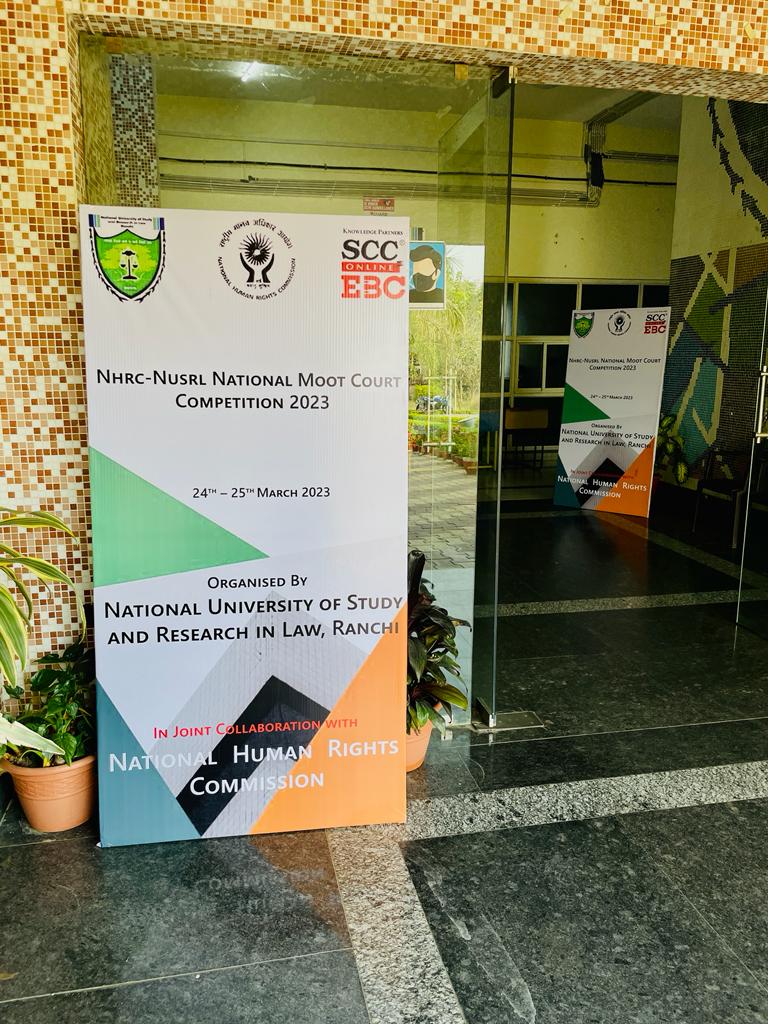
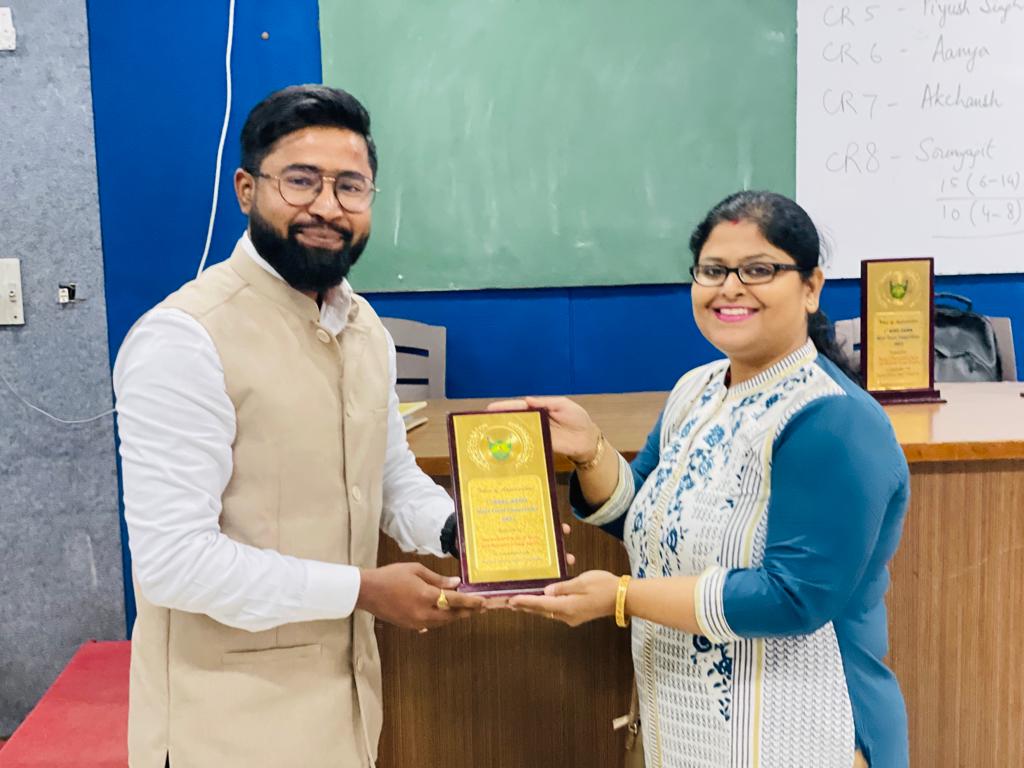
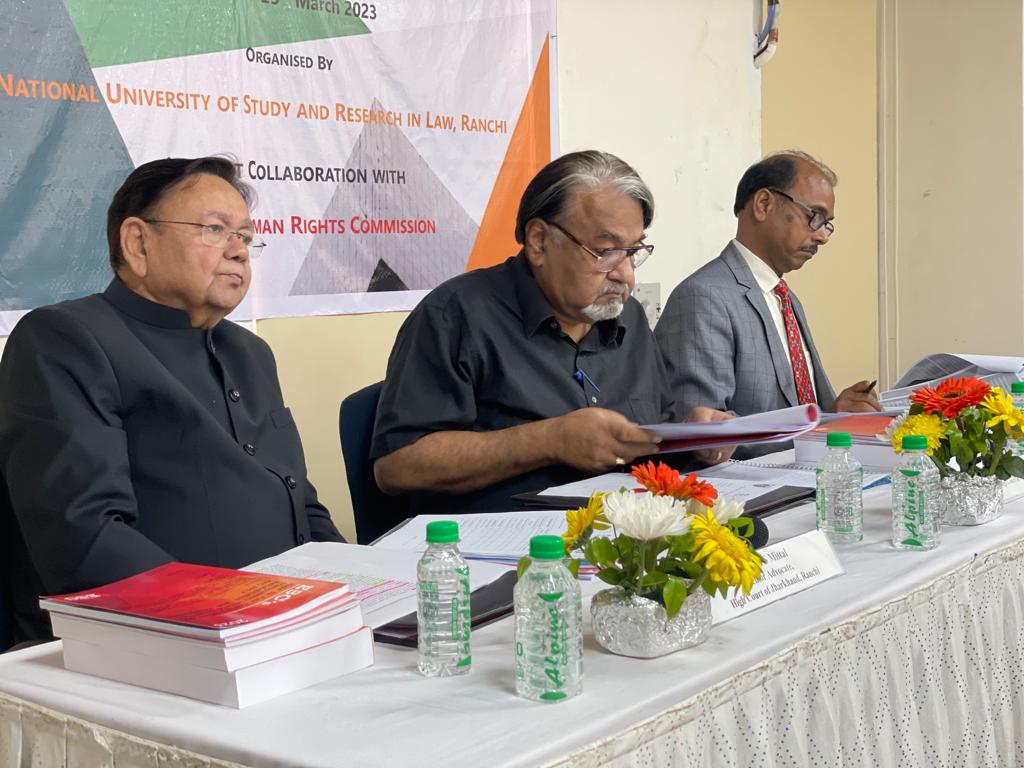
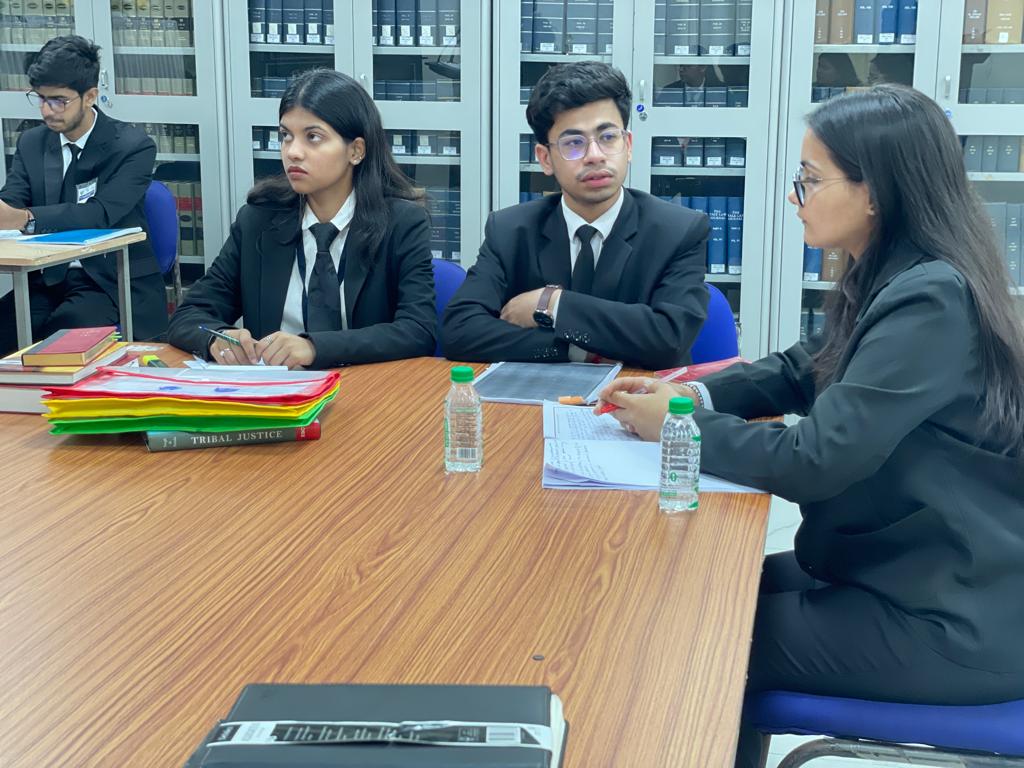
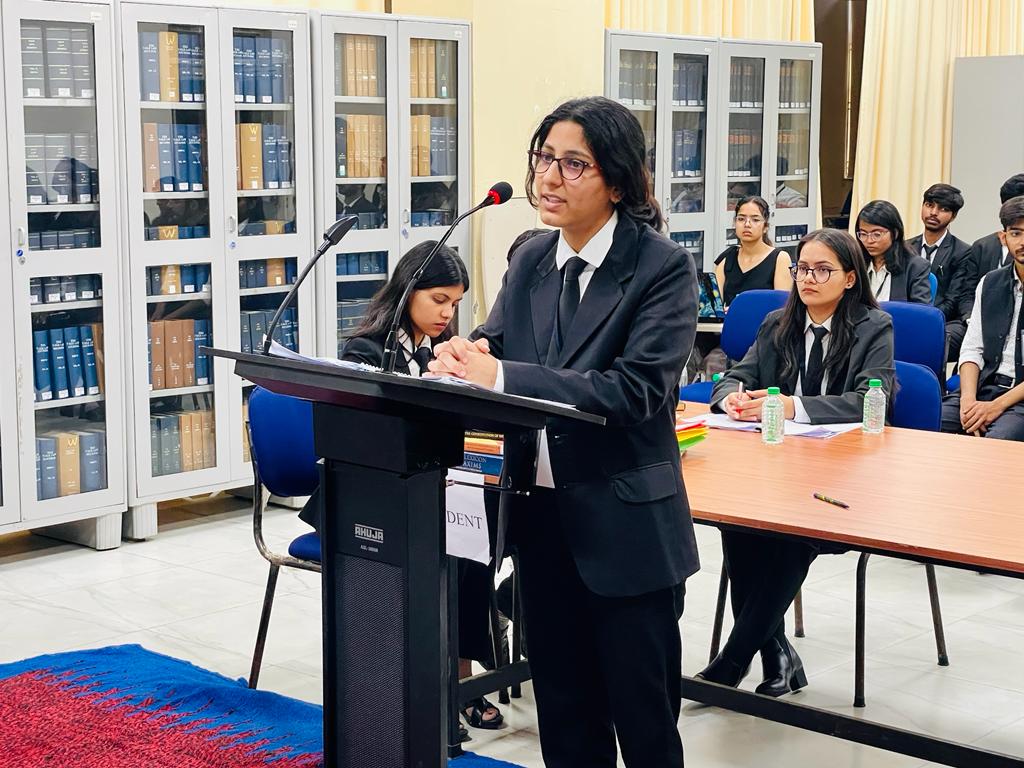
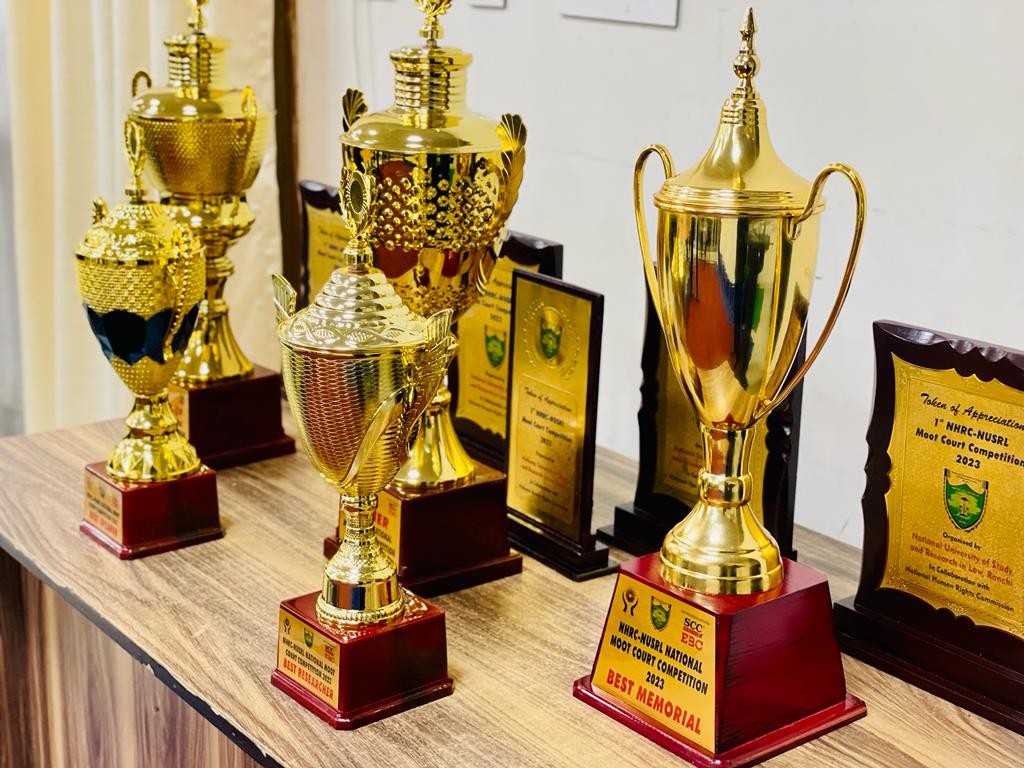




Very well drafted blog! Cheers to NUSRL for organising such an exciting moot competition.